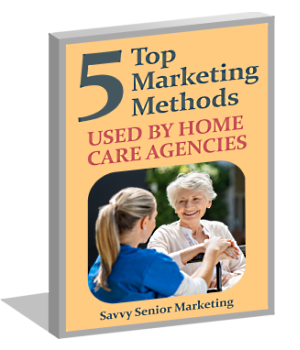Have you ever felt that the home care leads that you purchased were duds? That you were given fake contact info? You might be surprised, but here’s what we found in our simple study of 25 recent home care leads. We tracked down each of these leads. You’ll also learn what a top salesperson discovered as a way to solve this difficulty.
The truth about winning over your home care leads
Do you ever feel like you’re shouting into the void when calling home care prospects—only to be met with silence or disinterest?
“These leads stink!” you say.
You’ve invested in what you think are high-quality names. Yet the phone rings unanswered, or you’re brushed off with a quick “not interested.”
If this sounds familiar, you’re not alone. It’s a challenge that service-oriented businesses—especially those in non-medical home care—grapple with daily.
The modern prospect: hesitant and elusive
We at Savvy Senior Marketing have experienced this firsthand. Despite running well-targeted ads for home care services and receiving promising responses, many prospects never answer the phone. Others insist they never signed up in the first place. It raises the inevitable question: are people providing fake numbers just to browse without commitment?
Admittedly, we’ve all been there—curious about a service but hesitant to engage, even to the point of submitting a false number. But is this the norm for future home care clients?
Are prospective home care clients really interested?
To uncover the truth, we conducted a small yet revealing study. We analyzed 25 phone numbers submitted through pay-per-click ads for home care services.
The results? Eye-opening.
Using an online research service, we verified that all 25 numbers were real numbers—24 of them being cell phones. Of those, 20 matched the names provided in the ad form. The remaining five revealed no information at all. But that doesn’t necessarily mean that those five were false. Additionally, street addresses were overwhelmingly accurate, with 19 of 20 being valid.
What does this tell us? The majority of prospective home care clients are providing real information. So, if the leads are legitimate, the real challenge isn’t fake data—it’s reaching people who are reluctant to talk.
Persistence is key to nurturing home care leads
How a real estate agent reaches reluctant leads
Some business owners have cracked the code on making contact. One of them is Amber Hall, a real estate agent featured on YouTube channel 2Q Lead Generation Strategies. While her industry differs from home care, the same principles apply: persistence, courtesy, and smart follow-up.
Amber understands a universal truth—most people don’t want to answer calls from an unknown number. Instead of giving up, she employs a strategic multi-touch approach:
- The First Call – The prospect rarely answers.
- The Second Call – Ideally made later the same day.
- The Third Attempt – A call the following day.
- A Personal Video Message – If calls go unanswered, she records a short video on her phone, referencing the prospect’s specific request.
- A Voicemail with Options – She leaves a voicemail saying, “I want to help you find the right property or take steps to qualify for a mortgage. Or, if you’ve found something already, I can take you off my list.”
By positioning herself as a helpful expert rather than a pushy salesperson, Amber builds trust and increases response rates. Thus leads turn into clients.
Turning home care leads into clients
At Savvy Senior Marketing, we recommend a similar approach to getting home care clients. Instead of generic calls, make it personal:
- Reference why the person reached out (e.g., “I see you’re looking for home care for a loved one.”)
- Follow up with a personal video message via SMS to make a human connection.
- Consider calling in the evening, when many prospects are more available.
Of the 25 home care prospects we researched, the average age (among the ten we could verify) was 70 years old. While they may not work full-time, their children—who often make care decisions—likely do, meaning evening calls might be more effective.
And if they don’t know you from Adam — they’re not going to pull the trigger right away. After all, they are spending $6,000, $8,000 or more per month for home care. That’s a lot more than a home mortgage payment. You can’t blame them for taking their time.
Real estate expert Kevin Smullin, who interviewed Amber, also offered a key insight: “People give up too easily.” Too many businesses try once, get no response, and move on. But persistence—paired with tact and respect—pays off.
Respond right away to home care leads
Speed Matters: The Power of Immediate Follow-Up
One of the most effective strategies is responding right away when a prospect expresses interest. A sales study found that calling within five minutes dramatically increases the chances of making contact. And waiting even 90 minutes can cause 95% of prospects to forget who you are, according to Heath Media, a firm founded by Facebook marketing expert Ben Heath.
Automation tools like Mailchimp and Klaviyo can help by sending a welcome email and SMS immediately after a prospect submits their information. These platforms ensure that your business stays top-of-mind without requiring constant manual effort.
Tailoring a strategy to build home care leads
Are you asking, “How can I get good home care leads and nurture them?”
At Savvy Senior Marketing, we provide customized solutions to help agencies connect with home care leads. Depending on your team’s resources, we offer:
- Immediate lead notifications sent straight to your phone via SMS.
- Automated follow-up systems that include branded texts, emails, postcards and calls.
The silence of unresponsive home care leads doesn’t have to be the end of the conversation. With persistence, personalization, and prompt follow-ups, you can break through the noise and turn those quiet prospects into engaged clients.
Are you ready to refine your outreach strategy? Let’s talk about improving your home care leads with one of our systems. Click the button below.


